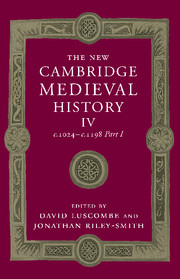Book contents
- Frontmatter
- 1 Introduction
- 2 The Rural Economy and Demographic Growth
- 3 Towns and the Growth of Trade
- 4 Government and Community
- 5 The Development of Law
- 6 Knightly Society
- 7 War, Peace and the Christian Order
- 8 The Structure of the Church, 1024–1073
- 9 Reform and the Church, 1073–1122
- 10 Religious Communities, 1024–1215
- 11 The Institutions of the Church, 1073–1216
- 12 Thought and Learning
- 13 Religion and the Laity
- 14 The Crusades, 1095–1198
- 15 The Eastern Churches
- 16 Muslim Spain and Portugal: Al-Andalus and its Neighbours
- 17 The Jews in Europe and the Mediterranean Basin
- 18 Latin and Vernacular Literature
- 19 Architecture and the Visual Arts
- List of Primary Sources
- Bibliography of secondary works arranged by chapter
- Index
- Frontispiece">
- Plate section"
- References
8 - The Structure of the Church, 1024–1073
Published online by Cambridge University Press: 28 March 2008
- Frontmatter
- 1 Introduction
- 2 The Rural Economy and Demographic Growth
- 3 Towns and the Growth of Trade
- 4 Government and Community
- 5 The Development of Law
- 6 Knightly Society
- 7 War, Peace and the Christian Order
- 8 The Structure of the Church, 1024–1073
- 9 Reform and the Church, 1073–1122
- 10 Religious Communities, 1024–1215
- 11 The Institutions of the Church, 1073–1216
- 12 Thought and Learning
- 13 Religion and the Laity
- 14 The Crusades, 1095–1198
- 15 The Eastern Churches
- 16 Muslim Spain and Portugal: Al-Andalus and its Neighbours
- 17 The Jews in Europe and the Mediterranean Basin
- 18 Latin and Vernacular Literature
- 19 Architecture and the Visual Arts
- List of Primary Sources
- Bibliography of secondary works arranged by chapter
- Index
- Frontispiece">
- Plate section"
- References
Summary
it is no coincidence that the terminal dates of this chapter should respectively refer to the promotion of an emperor and of a pope, for they serve to delimit forty-nine years which witnessed a decline in the power and prestige of the German emperors and an energetic and lasting papal revival. In 1024, Conrad II (1024–39) became king of Germany, the first of the Salian house; in 1027 he was crowned emperor at Rome by Pope John XIX, a scion of the local Tusculan family, who had become pope also in 1024. According to his biographer Wipo, the rhetoric at his royal anointing was extravagant: Archbishop Aribo of Mainz declared, ‘You have come to the highest office; you are the vicar of Christ.’ In 1073, Hildebrand, archdeacon at Rome since 1058, became Pope Gregory VII (1073–85). From Lorraine, Abbot Walo of Metz was prompt in congratulation: ‘the Lord had caused one well versed in ecclesiastical duties to sit on St Peter’s throne, whence the light of all virtues radiated through the world and where all things converged as, in a circle, the radii meet at the middle point that geometricians call the centre’. In 1024 a king-emperor seemed to be at the world’s focal point, but in 1073 the pope. The contrast was a sharp one because of a crisis in papal affairs half-way between these dates. During the winter of 1045–6, Conrad’s son and successor Henry III (1039–56) undertook a Roman expedition and set aside three claimants to the papacy who had been contending since 1044.
- Type
- Chapter
- Information
- The New Cambridge Medieval History , pp. 229 - 267Publisher: Cambridge University PressPrint publication year: 2004
References
- 1
- Cited by

